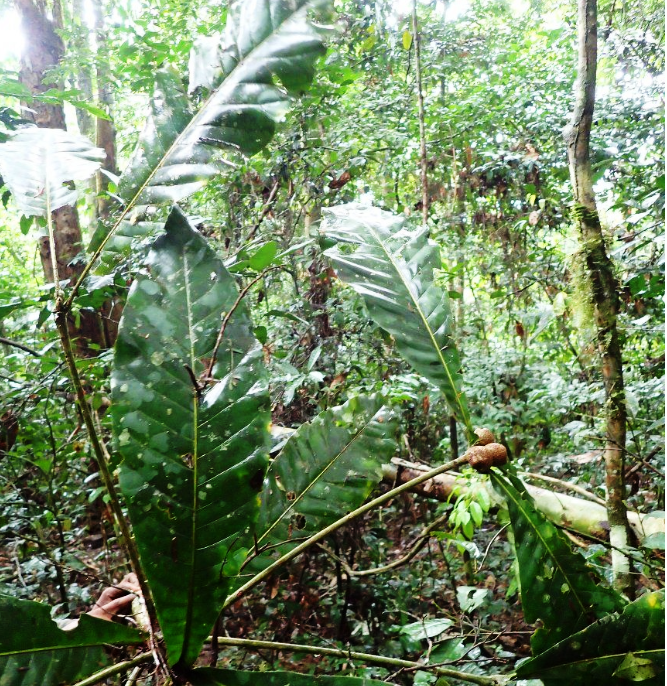Schumanniophyton magnificum

|
|
Schumanniophyton magnificum Common Names: Magnificent Shrub, Ogunfe Scientific
Classification Kingdom: Plantae Phylum: Tracheophyta Class: Magnoliopsida Order: Gentianales Family: Rubiaceae Genus: Schumanniophyton Species: S. magnificum Synonyms: Schumanniophyton
magnificum var. magnificum, Schumanniophyton magnificum var. klaineanum (Perre ex A.Chev.) N.Hallé Morphological Description Schumanniophyton magnificum is a small to medium-sized tree or shrub, typically 4–5 m
tall, occasionally reaching 10 m. Its key features include: · Stem: Soft-wooded, grayish-brown bark, often used medicinally · Leaves: Glossy, dark green, opposite, ovate to elliptic, 15–30 cm
long, 10–15 cm wide · Flowers: White to yellowish, fragrant, borne in dense terminal
clusters subtended by broad bracts · Fruit: Small, ovoid, 1–2 cm long, green turning brown, containing
1–2 seeds Distribution and Habitat Schumanniophyton magnificum is native to tropical Central and West Africa, spanning
Nigeria, Cameroon, Gabon, and northern Angola. It thrives in: · Ecosystems: Lowland rainforests, riverbanks, and swampy areas (0–500 m
altitude) · Soils: Moist, organic-rich, acidic soils (pH 4.5–6.0) · Climate: High humidity (80–90%), annual rainfall 1,500–3,000 mm,
temperatures 25–30°C It often grows near
water sources, enhancing its accessibility for traditional use (Burkill, 1997). Ethnopharmacology Schumanniophyton magnificum, has been traditionally employed for various medicinal purposes,
including treating dysentery, snake bites, and as a post-circumcision lotion.
Scientific studies have substantiated several of these uses, revealing that
extracts from the plant exhibit antibacterial activity against pathogens such
as Escherichia coli and Staphylococcus aureus, supporting its application in
managing urogenital infections. The plant also demonstrates anti-inflammatory
properties through phospholipase A₂ inhibition, which may explain its
traditional use in snake bite treatments. Additionally, S. magnificum has shown
antihyperglycemic and antioxidant effects, suggesting potential benefits in
managing insulin resistance and protecting against organ damage. Furthermore, the
leaves exhibit antimalarial activity without notable toxicity, aligning with
traditional malaria treatments. · Antimalarial: In Cameroon, bark extracts showed in vitro activity against
chloroquine-resistant Plasmodium falciparum (IC₅₀ 10–50 µg/mL), linked to chromone glycosides (Bickii et
al., 2007). · Anti-snake Venom: In Nigeria, stem bark peptides inhibited
cobra venom effects on chick biventer cervicis muscle, attributed to
schumanniofoside (Houghton & Harvey, 1989). · Antibacterial: Leaf extracts exhibited activity against Staphylococcus aureus (MIC 64 µg/mL), supporting wound treatment
in Gabon (Joshua et al., 2020). · Anti-inflammatory: Bark decoctions reduced inflammation in
dysentery treatment; linked to noreugenin and rohitukine (Tane et al., 1990). · Aphrodisiac: In Cameroon, aqueous extracts doubled testosterone levels
(2.15 ± 0.70 ng/mL) in rats, supporting Baka Pygmy use (Wikipedia, 2023). ⚠ Toxicity Profile: No acute toxicity is well-documented; LD₅₀ of
ethanolic leaf extract in mice is >2,000 mg/kg, suggesting low toxicity.
Caution is advised due to bioactive compounds (Joshua et al., 2020). Additional Uses · Cultural: Used in Gabonese rituals for its psychoactive properties,
likened to Tabernanthe iboga (Wikipedia contributors, 2023). · Ecological: Stabilizes riverbank soils, reducing erosion (Fern, 2024). · Pharmacological: Chromone glycosides (e.g.,
schumanniofiosides A and B) are studied for drug development (Tane et al.,
1990). References
External Links More Pictures
|
|
| Compounds of Schumanniophyton magnificum | |
| References |